You’re in the middle of nowhere when your child asks you for some water. You reach into your purse to discover you left your Watsons drink in the cab that hurriedly sped away after getting his money. You turn to your husband to ask for his water but he tells you he forgot it in the cab as well. How you both left your water bottles in the cab beats me, so before you can argue with the author of your silly predicament about the strange story she’s put you in, your child reminds you of her still unquenched thirst. You breathe, focus, and then look around for the nearest convenience store.
Aha! You spot one—it’s just right across the street. You troop your family to the convenience store and there ask for a few bottles of water. The tummy-exposed, hole-ridden-couch-lying vendor grunts his displeasure that his TV watching has been interrupted for just a few kuai, and he grabs a few bottles and rolls it towards you without breaking eye contact with his show. “Six kuai,” he says in Chinese, although in your country that sounded more like a reprimand than a statement. Your child’s almost lifeless grumble brings you back to the present and as you grab the water bottles and slowly reach one out to your child one thought suddenly crosses your mind.
Wait, is this safe?
Your child reaches for the water bottle just as you pull your own arm back, mommy instincts suddenly going into overdrive. “Do you have anything else other than this?” You ask in your elementary Chinese as you try to return the bottles. The bottles are so soft they succumb almost effortlessly when you accidentally squeezed. You remember that recent post about Drinking Waters and Shower Filters and can’t help but gulp down worry.
“No, that’s all,” says the vendor, annoyed that you’re still there. Your daughter screams at you for keeping her precious water away from her, and she’s seconds away from jumping up and down and releasing her unforgiving Intense Scream of Hatred. You sigh with resignation. You give the rest of the bottles to your husband and open one for your child, who downs the whole bottle as if she had just walked through a desert.
And finally you do the one thing you’ve been meaning to do since this fiasco began. You look up to the heavens knowing I’m still typing your story and you go, “Why in the world is there only one type of bottled water in that man’s shop?!”
Hmm.
If you’ve been in the same situation once or twice before (not referring to the screaming-to-the-heavens part) or feel you might be faced with one during your expat years in the capital, then you’ve come to the right post. You’ll encounter a bunch of water bottles during your stay here in China, and yet won’t really have any way of knowing which is your best option unless you have a Xiaomi TDS and a little cup to test your water’s PPM. In other words, it’s just a load of 麻烦 (má fan). Fortunately dear reader you’ve got us, and we’re here to tell you whether or not you’ve chosen the right poison (err… drink).
To aid in our quest for the best on-the-go water option is the Xiaomi TDS Pen Water Quality Tester, a nifty device that looks quite similar to a pen on the outside but is secretly a water purity spy for us Beijing-based folks. The instructions are simple enough: take off the cap, press the ON button and dip it in the water in question. A few seconds is all it takes for the TDS Value to appear on the tiny screen.
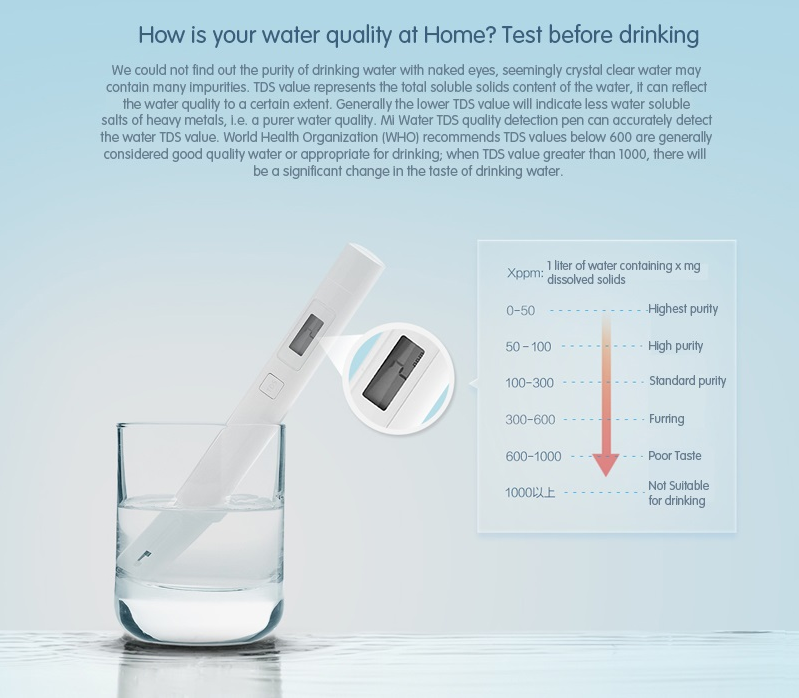
You’ll want this number as low as possible, because a high value means that the water you’re about to drink might be high in dissolved solids or worse—not within drinkable ranges. If you’re wondering what “dissolved solids” here means, here’s how Xiaomi explains it:
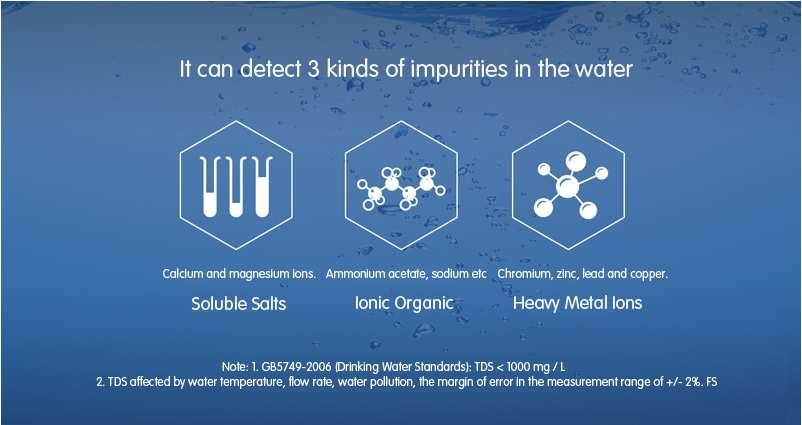
So for this experiment I chose some popular water options amongst foreigners, some amongst locals, and some from one of the nearby newspaper stores. And then I list their respective TDS levels and their price per bottle. Unless stated otherwise, prices below are all Carrefour prices.
So here are the results:

1. Snow Mountain Mineral Water: Differs from water bottle to water bottle, but generally straddles between 238 to 271 ppm, (RMB 5 for 510ml)
I was very surprised to discover that this water’s TDS Value was so high, considering that it’s quite expensive and that there’s this famous movie company that uses this. To make sure it wasn’t just the problem wasn’t with the specific bottle I had bought, I decided to purchase another one at Carre Four. The number went lower, but really not by much. So for those who think that price always means quality, I’m not sure that’s the case here.
2. C’est bon Purified Drinking Water: 6 ppm (RMB 3 for 350ml in our neighborhood shop but just the same price as Nongfu elsewhere)
This is a popular choice amongst my friends since it costs almost the same as a bottle of Nongfu, which honestly surprises me considering it’s a foreign brand. Also, considering how low the ppm is it’s definitely a steal!
3. Nongfu Spring Water (Natural Stone Mineral Water): 35 ppm, (RMB 2.35 for 535ml)
I first met this version of Nongfu on the bullet train to Tianjin, when we visited the Aircraft Carrier Theme Park. I remember it costing around RMB 6 during that ride, and found it quite pricey at the time. But now that I’ve checked its ppm level I think it was the right choice. After all, I was buying it not just for myself but for my kids to drink as well.
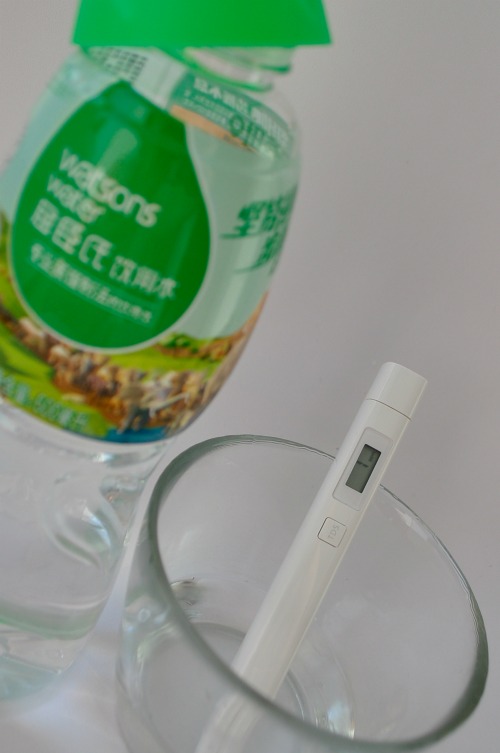
4. Watsons Water (the green bottle): 1 ppm (RMB 2.40 for 400ml)
Watsons seems to be the number one option for expats, but my beef with this famous brand is that it’s quite pricey. I know, I know, you can’t put a price on health. But when you’re buying liters and liters of this you really need to ask yourself if spending that much on water really needs to be such a high priority (P.S. Check out that A++ ppm level!)
5. Hosanmi Drinking Natural Mineral Water (Deep Volcano Mineral Water): 122 ppm, (RMB 3.5 for 542ml)
I bought this water as well because it was one of the options at our neighborhood convenience store. It looks AND sounds cool – Deep Volcanic Mineral Water – whoa that’s got to be freaking healthy right? But I was surprised to see a high ppm level from this particular mineral water. Hm. Oh well. Looks were quite deceiving after all.
6. Nongfu Spring Water (the normal one): 66 ppm, (RMB 1.5 for 550ml)
A popular choice amongst many Chinese I know because, well, it’s Nongfu. It’s a big name, and even with its scandal years ago I still see a lot of people drinking it. Worse, many leave it in their cars which, when warmed, makes the bottles release antimony, a trace heavy metal that has been linked to several diseases.
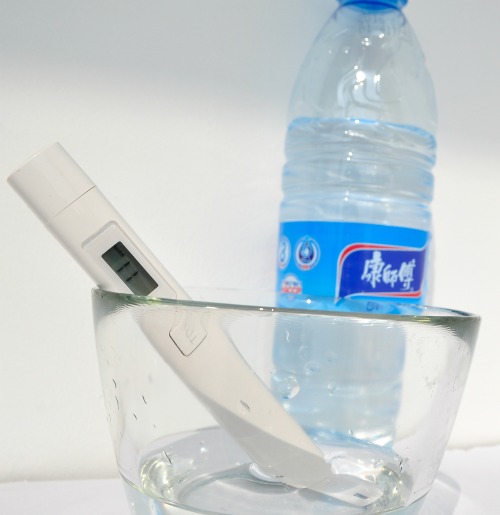
7. Master Kong Bottled Water (Kangshi Fu) : 11ppm (RMB 8.8 for 550ml x 12 at Carrefour, RMB 2 for 550ml at the newspaper shop)
This honestly came as a big surprise to me, considering how cheap it is! This bottled water would have definitely never made my list of waters to drink had I not tested it.
8. Ganten Natural Mineral Water: 39 ppm (RMB 3.6 for 570ml)
This has been our choice water for awhile, not realizing that C’est bon was actually better in terms of ppm level! But it’s still good to know that our bottled water’s TDS gauge is still within the highest purity limit.
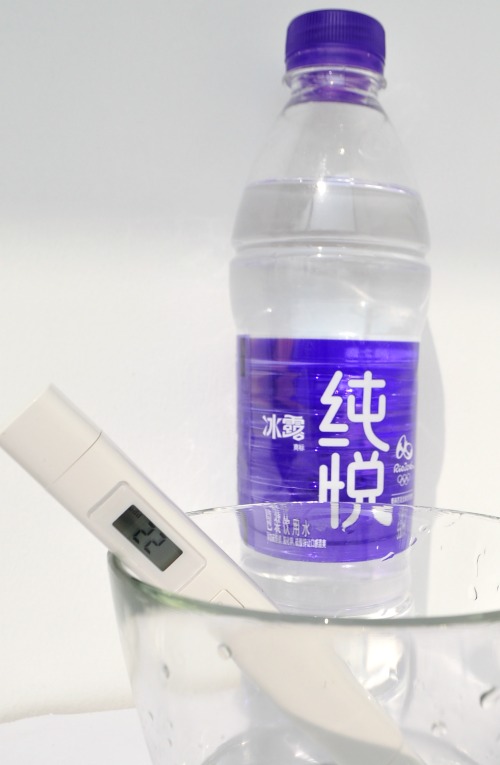
9. Bing Lu Purple Olympic brand: 22ppm (RMB 1.8 for 550ml)
Anything with the Olympic seal will catch a fan’s attention, and fortunately the TDS levels are within acceptable range.
10. Evergrande Spring: 87ppm (RMB 4 at the newspaper shop)
This is one of the three bottled waters I saw at the newspaper shop, and naturally I decided to also test this. For those who have to choose between this bottled water and Nongfu, the latter is still a better choice.
So the winner of the Water Purity contest is…. Watsons! But availability might be a problem especially for those traveling. In those cases, C’est bon, Ganten, and fortunately Master Kong bottled waters are great alternatives as well.
Photos: Xiaomi and Jackie Park





10 Comments
PPM is not the only matter you should test. For example, Watson’s Water has very low PPM, sounds very good. But, it is not, bcs the pH is ONLY 6.5, acidic and dangerous. Water with less than 150 PPM TDS and 7.5 to 8.0 pH is a good one.
Hi Doc,
Oh wow, I didn’t realize that! Thank you very much! I’ll look into how to research that. Thanks a lot!
Good experiment. I was also curious and did the same at-home TDS test with a variety of bottled waters. After doing some online searching and posting my test findings to friends I discovered that a higher TDS reading is not necessarily bad- many natural mineral waters have higher readings than tap water. Evian water is listed on its website as 309 ppm.Fiji water lists itself as 224 ppm and both of these are considered premium brands. Beneficial Minerals such as calcium, magnesium and potassium are present in higher quantities in many mineral waters. TDS solids can come from natural sources as well as manmade sources. I also measured distilled water, which of course was 0ppm. World drinking water guidelines say that TDS readings under 500ppm are desirable for drinking water. I had thought my TDS reader would show impurities like microorganisms or bacteria, which it doesn’t. So when I discovered my TDS readings for my tap water and expensive bottles mineral water were both over 300 I panicked. But it’s safe to drink one and not the other! Anyway, kudos to you for doing this — with vendors reusing and refilling bottles with who knows what it can be nerve wracking. Thanks again!
Wow you’re right! This is interesting. It’s such a struggle to find the best bottled water for our children, isn’t it? Glad you liked the post though, will see what additional research I can do. Thank you!
Dear Jackie, I’m glad that there are moms in Beijing like you who are concerned about the quality of our drinking water. I work in the bottled water industry and hope I can answer some of these concerns. Please contact me via wechat “maiaquaservice”.
As a general guide I would say that the good things you want in your water are minerals such as Calcium and Magnesium which is also how you measure the hardness of a water. But also Iron, Zinc and other elements are beneficial in small quantities. Furthermore you want to have some electrolytes such as Chloride, Potassium and Sodium especially if you want to quench your thirst after some exercise. And as mentioned above by others the pH or alkalinity levels are very important. Especially if you eat salty foods like snacks or anything fried. I actually suffer from acid reflux that sometimes turns into stomach ulcers and I have discovered that water that is more alkaline helps to balance my body again.
What you don’t want in your water are of course bacteria, pesticides, hormones, heavy metals and other microbial inorganic chemicals that are harmful to your body. The question of course is what are these specifically and are they in fact in our water. To answer that we must determine how you consume water. Please let me know whether you drink tap water or bottled. And more importantly if it’s tap water which filter do you use and if it’s bottled water what is its source? Is it natural mineral water or spring water or is it purified water? Then we can continue to determine how we test our drinking water and I think that is where the misunderstanding with the Xiaomi TDS meter occurred. Since it was meant to measure the tap water before you use the Xioami water filter but you went ahead and tested it with bottled water. Don’t get me wrong, some bottled water is nothing more than tap water in a bottle. I’d be happy to tell you more about a) different types of bottled waters b) Chinese and international standards for bottled water c) standards for tap water d) How to test our water and perhaps which water is best suited for your lifestyle.
Which brands of water are distilled? I need some for my humidifier as anything else builds up a horrible, crusty residue inside it
Hi Mika, thanks for your comment! This post is three years old, so it might be best to contact Gotz directly with the details above. However we haven’t done a round up of different waters for a while, so we’ll look to cover that again soon.
Mineral water are full of minerals so it should have a higher ppm than purified water
Water taste depends on contain present in it. If water is contaminated then smell the odor and not test well, on another side if its clean and bacteria free then it doesn’t smell and taste well.
In short, PPM is ‘parts per million’ which is a measure of ANY (both good and bad) particles in the solution (water) and using it as a ‘measure of quality’ for mineral waters is akin to using kcal as the ‘measure of quality/ healthiness’ of food – without making difference between proteins/ complex carbs and trans-fats and sugar…
Mineral Waters (yes, the ones you pay a premium for) have much higher PPM as they actually contain minerals (Calcium. Magnesium…) that are important for human body (the ones you are otherwise likely to replenish via pills and other artificial sources). The ones with 0 PPM are distilled waters – which is not even good to drink in a long run as it wash your body from nutrients.
Well it’s sad to see how people with zero knowledge pretend to be ‘experts’ and share their opinion on topic they do not know a dime about…In pre-internet era that was fine – but now this kind of ‘fake news’ spread quickly – and we have a generation of people drinking ‘zero value’ distilled water thinking they are doing right